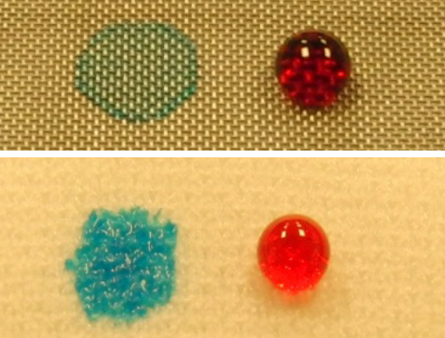Welcome to this week’s 21st Century Technology headlines. Each week I select a few interesting stories about technological innovation that can help us tackle the problems we face this century. As always I encourage you to comment, ask questions and provide input on topics I write about or feature. This week focuses on drip irrigation in India, biomedical technology that could replace doctors, using computers as a prescription against dementia, a new filtering technology that could help clean up oil spills, and some novel concepts for supersonic commercial aircraft. Enjoy the read.
Agriculture Update: Netafim Irrigation Technology – A Scarce Water Solution
A leaky water pipe and a flourishing tree revolutionized irrigation over 50 years ago and what was discovered by accident has led to the development of micro-irrigation products by a company in Israel called Netafim. Its micro-drip technology adapts to operational and environmental conditions maintaining directed water flow to field or greenhouse crops. Today the company is providing training and assistance to farmers in 110 countries developing micro-irrigation solutions that increase water use efficiency to 95%. In April Netafim opened a new facility in India to assist more than 50,000 farms in the country. India, a country with 1.2 billion people , 17% of the world’s population, contains only 4% of its fresh water. With 77% of that water designated for agriculture, maximizing water use is critical to increasing crop yields. Crops under micro-drip irrigation include cotton, sugarcane, potatoes and bananas grown in open fields as well as green houses.

Biomedicine Updates
Hey Doc – You May Soon Be Replaced by a Machine
At the Health Innovation Summit in late August in San Francisco, Vinod Khosla, a co-founder of Sun Microsystems and a partner in a health venture capital firm, described a future in which applications on smartphones would replace 80% of physicians. Khosla demonstrated AliveCor’s ECG Heart Monitor, a low-cost mobile device that enables a patient to monitor his or her heart health anywhere, anytime and that attaches to an iPhone. The monitor is one of a number of consumer-oriented medical products that Khosla’s firm is funding that allow consumers to measure and assess their own wellness. And with Watson (see last week’s headlines) learning to become a medical whiz on behalf of WellPoint Inc., machine learning systems may soon prove to be better at diagnosis than most doctors.

Using Computers to Stave off Dementia
Today dementia affects 13.3 per 1,000 population. But here is a prescription you can take if you are getting to your senior years like me. “Take one personal computer, laptop, tablet or smartphone session a day and call me in the morning because you’ll remember my number. According to a research study done by the University of Western Australia, regular computer use is a formula for lowering incidents of dementia in older males. The study followed 5,506 men between the ages of 69 and 87 for a period of up to 8 1/2 years. The results, a decrease in dementia rates of 40%. Computer usage was measured by frequency and type of activity. Follow up showed a correlation between frequency of computer use and cognitive abilities.

Environmental Technology Update: New Filter Separates Oil From Water
Imagine a filter that cleans up oil spills in the ocean or separates oil from water in fresh water treatment plants. In the past membranes separating water and oil have fouled up after a few hours. But not this technology created by engineers at University of Pittsburgh. The filtering agent consists of two compounds: POSS (fluorodecyl polyhedral oligomeric silsesquioxane) and PEGDA (polyethylene glycol diacrylate). When applied to surfaces such as wire screening, filter paper or fabric, water passed through while oil was blocked. Tests in the lab on canola oil and diesel fuel produced optimal results. Next in the plans, a field test in the ocean. Where are you BP?

Transportation Update: Is There a Supersonic Flying Wing in Your Travel Future?
NASA’s Innovative Advanced Concepts Program has awarded engineers at University of Miami $100,000 in funding to turn their bi-directional flying wing idea into a reality. The wing looks like a Ninja warrior’s star with four wings at 90 degrees to each other. When in subsonic flight the aircraft uses one set of wings. When in supersonic flight it rotates and uses its other set. The jet engines atop the aircraft re-align for the type of desired flight. For passengers on board, a 5-second rotation would create g-forces less than those experienced during commercial jet flights today.
Not to be outdone, engineers at Tohoku University in Japan have come up with a supersonic biplane concept that produces no sonic boom. Supersonic commercial air travel ended with the Concorde. Will we see it revive? Most experts believe concepts like these will take 20 years to go from the drawing board to commercial use. My bet is we will see sub-orbital commercial rocket service between New York and Tokyo before either of these two interesting airplanes ever fly.

A Postscript
Readership continues to climb every month. Thank you. You can find 21st Century Tech on Facebook as well. If you go that route please “Like” the page. I’m 10 short of 30 readers. Once I reach that number I can begin to analyze reader traffic on that site. To the more than 4,000 of you who visited last month, thanks for dropping by and keep on coming back. I promise to keep you interested and intrigued about 21st century technology and our future. – Len Rosen
















Len says: “My bet is we will see sub-orbital commercial rocket service between New York and Tokyo before either of these two interesting airplanes ever fly.”
That seems a very safe bet. An aircraft can move through the air only by doing the work of moving air out of its way along its path of motion. An aircraft cannot advance unless it moves the mass of air in its path of motion out of its way. The energy to do the work of moving the mass of air out of the plane’s way must come from the combustion of fuel in the plane’s engines. But several of the fundamental iron “Laws” of physics require ever increasing fuel consumption at increasing speeds.
As an airplane travels faster, it must move increasing masses of air out its way per unit of time. But the demand for energy to move the air out of the way increases exponentially while the speed increases only linearly. That’s because kinetic energy, “E=1/2 MV2,” is a function of the velocity squared. So, it takes four-times the energy (fuel) for the plane to displace air twice as fast. But the nonlinear energy demands at higher speeds is even worse than that. The “sound barrier” results from the finite mean molecular velocity of air molecules (say about 700 mph). Pressure waves in air cannot propagate at speeds greater than the mean molecular velocity of air molecules. So as a plane speeds into the supersonic regime, not only must it move the mass of air blocking its path out of its way at ever increasing speeds, it must move ever increasing masses of air not in its path out of the way because zones of compressed air couple the plane’s kinetic energy to air outside of its path. So the mass of air that must be displaced in supersonic flight increases exponentially.
The only possible solution to sustained high-speed fight is the one the commercial aviation industry routinely employs: Reduce the density of the air the plane must pass through. Commercial airliners take off and immediately begin ascent to altitudes above 35,000 feet, where the air is much “thinner” than at say 5,000 feet. Much less energy is required to push a much lower mass of air out of the plane’s path of travel, so fuel consumption is reduced even though speed is increased. But commercial airliners, regardless of altitude, restrict speeds to below 90% of the mean molecular velocity of the air the plane must displace. That must be done to reduce coupling the plane’s kinetic energy to masses of air outside its path of motion. So supersonic flight that creates the compression waves that couple to air mass outside the path of motion, can only be achieved in very thin air, and that means very high altitudes and very high fuel consumption. Why not just fly at 100,000 feet at supersonic speeds, as would be characteristic of the flight profile of the old SR-71 Blackbird spy plane.
Well, another iron “Law” of physics begins to dominate. Let’s just call it the kinetic theory of gases, which states in effect, “The temperature of a gas is proportional to its mean molecular velocity.” As a plane travels faster, the relative velocity of the plane rises compared to the air molecules it must displace along its path of motion, so in effect the plane must pass through air that increases in temperature with speed.
The SR-71 was constructed largely out of titanium, and cooling liquid (fuel) was circulated to cool the surfaces exposed to the highest temperatures. It’s highly unlikely that any airplane will ever fly through the atmosphere in sustained flight any faster than did the SR-71, because the temperature control problem is so intractable and titanium is so expensive. So high-speed commercial travel over long distances must take place in near vacuum. Concord failed as a commercial venture because it wasn’t designed to fly outside of the atmosphere, and the laws of physics don’t allow economical supersonic flight within the atmosphere. Rapid travel between New York and Tokyo must be “space” travel, not air travel. I’m betting that for the next several centuries almost all commercial travel between New York and Tokyo will be limited to subsonic speeds, say in the range of 600 mph.
Virgin Galactic is already talking about moving to commercial sub-orbital passenger flight between continents. This would be a premium service for a select few passengers. I wonder when a SpaceShipThree will be announced?
I just don’t see it ever happening. The issue is much like the “man in space” problem. Unless and until some fundamentally new physics allows reusable “single stage to orbit” systems, costs, environmental, and safety concerns, overwhelm the proposition. Actual Concorde costs per passenger mile were probably five times greater than 747 costs. So one could plausibly, though weakly, argue that a sufficient number of super-rich trans-Atlantic travelers could sustain the program. But a rocket service wouldn’t cost five times more per passenger mile than 747 service; it would cost at least 50-times more. To compound the high cost obstacle, costs of high-quality real time “virtual presence” are rapidly falling. So it seems likely pre-positioned virtual presence android robots will be developed before practical sub-orbital “space-planes.” The “airline” would just operate the android robots throughout the world and the travelers would just enter holodecks to instantly link to their android “presences” already pre-positioned at the desired destinations. It would be like current teleconferencing raised to a 3-dimensional power. Major corporations and the super-rich would maintain in-house holodecks and androids for instantaneous “travel” to common “destinations.”
Sure there would be a few of the super-rich that would want to go “in person,” but probably far too few to sustain a commercial space plane venture. The super-rich that just want to ride a roaring rocket and experience sustained weightlessness can visit some remote desert launch complex and pay Sir Branson or the Russians millions for the adventure. For most practical purposes large turbofan powered airliners that are limited to 0.9 Mach speeds and built by Boeing are likely to completely dominate the New York to Tokyo or London to Hong Kong travel market for the next 50-years.